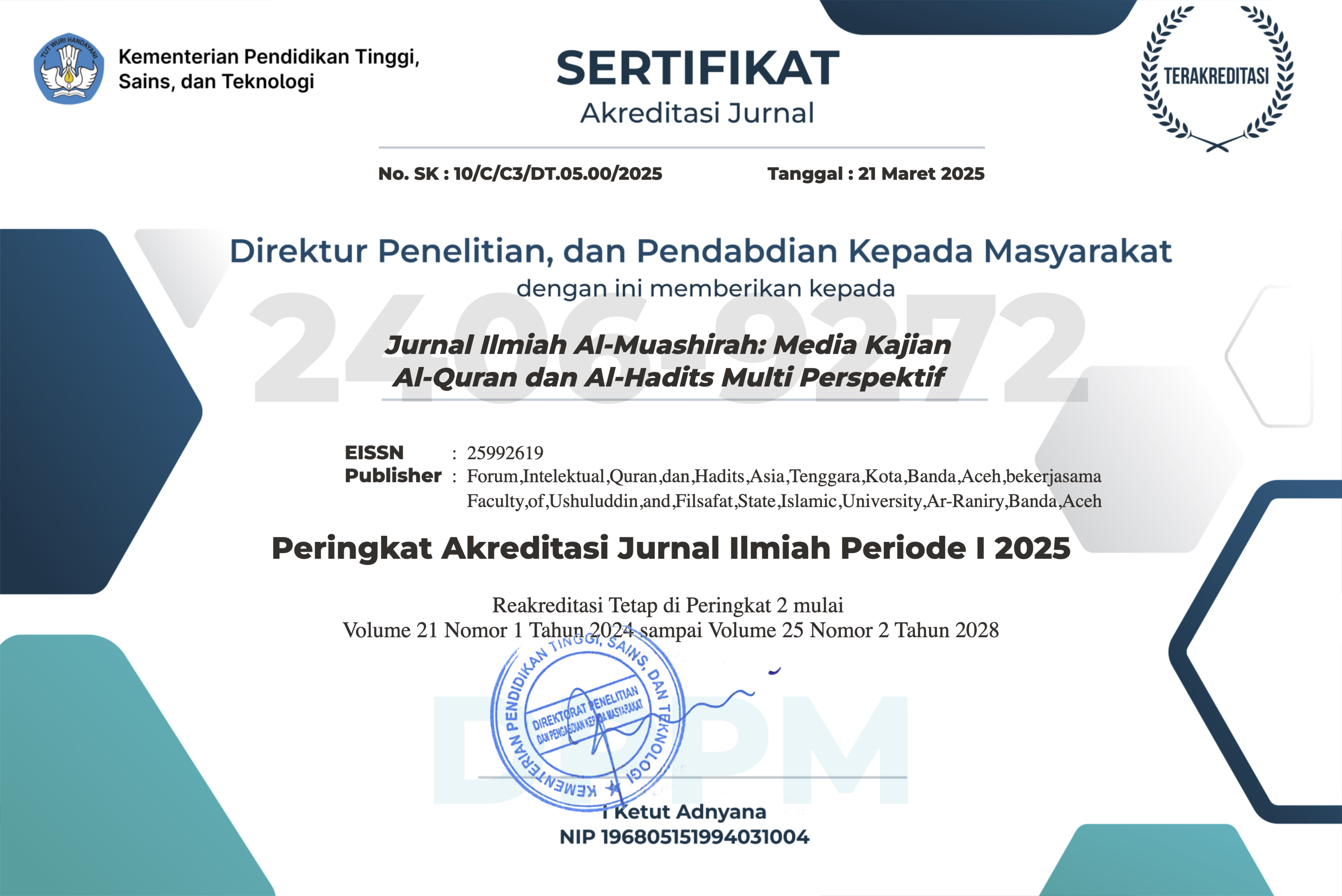History of the Development of Nagham Al-Qur'an in Indonesia
DOI:
https://doi.org/10.22373/jim.v20i2.18726Keywords:
Quran, Nagham, Qari.Abstract
Nagham is an art form of reciting the Quran. The application of art in reciting the Quran is highly dependent on the rules of Tajweed. Reciting the Quran according to Tajweed rules is a command found in the Quran and Hadith. By reciting the Quran by the rules of recitation, a beautiful sound melody called "nagham" is created. However, this artistic melody does not have a musical scale or musical notes. Therefore, the focus of this research is to examine the development of nagham in Indonesia. This study aims to explore the development of Nagham in Indonesia in greater detail. The method used is descriptive and analytical. This research reveals that there are seven nagham styles in Indonesia: Bayyati, Shaba, Hijas, Nahawan, Rast, Sika, and Jiharkah. On the other hand, the application of nagham varies among different reciters (qari).
Downloads
References
Al-Sid, Muhammad ‘Atta, Sejarah Kalam Tuhan Kaum Beriman Menalar Al-Qur’an Masa Nabi, Klasik Dan Modern, ed. by Ilham B. Saenong (Jakarta: Teraju, 2004)
Azra, Azyumardi, Jaringan Ulama Timur Tengah Dan Kepulauan Nusantara Abad XVII Dan XVIII: Akar Pembaruan Islam Indonesia (Jakarta: Kencana, 2007)
Crowther, Jonathan, Oxford Advanced Learner's Dictionary (Oxford: Oxford University Press, 1995)
Farmer, Henry George, The Influence of Music from Arabic Source (Leiden: Leiden University Press, 1965)
Indra, Moersjid Qorie, Seputar Nagham Seni Baca Al-Qur’an (Qaf media, 2019)
Jauziyah, Ibnu Qayyim al, Aunul Ma’bud Syarah Sunan Abu Daud (Jakarta: Pustaka Azzam, 2008)
Muhaya, Abdul, Bersufi Melalui Music: Sebuah Pembelaan Music Sufi Oleh Ahmad Al-Ghazali (Yogyakarta: Gama Media, 2004)
Munir, M. Misbachul, Pedoman Lagu-Lagu Tilawati Qur’an Dilengkapi Dengan Tajwid Dan Qasyidah (Surabaya: Apollo Lestari, 1997)
Nelson, Kristina, The Art of Reciting the Qur’an (Bandung: Mizan, 2001)
Noorhidayati, Salamah, Hibbi Farihin, and Thoriqul Aziz, ‘MELACAK SEJARAH DAN PENGGUNAAN NAGHAM ARABI DI INDONESIA’, QOF, 5.1 (2021) <https://doi.org/10.30762/qof.v5i1.3592>
Shalihah, Khadijah, Peranan Suara Dan Nada Dalam Melantunkan Lagu-Lagu Al-Qur’an, Dalam Buku Bunga Rampai Mutiara Al-Qur’an, Pembinaan Qari- Qariah Dan Hafiz-Hafizah (Jakarta: Pimpinan Pusat Jam’iyyatul Qurra’ wal Huffazh, 2006)
Suarni, Suarni, ‘Development of the Nagham Qur’an’, Jurnal Ilmiah Al-Mu’ashirah, 20.1 (2023), 50 <https://doi.org/10.22373/jim.v20i1.16494>
Sulayman, Abu Dawud, Sunan Abu Dawud (Beirut: al-Risalah al-‘Alimiyah, 2009)
Syahid, Ahmad, Sejarah Dan Pengantar Ilmu Nagham, Dalam Bunga Rampai Mutiara Al-Qur’an, Pembinaan Qari-Qari’ah Dan Hafizh-Hafizah (Jakarta: Jam’iyyatul Qurra’ Wal Huffazh (JQH), 2006)
Downloads
Published
Issue
Section
License
Authors who publish in Jurnal Ilmiah Al-Mu'ashirah agree to the following terms:
- Authors retain copyright and grant the journal right of first publication with the work simultaneously licensed under a Attribution-ShareAlike 4.0 International (CC BY-SA 4.0) License that allows others to share the work with an acknowledgment of the work's authorship and initial publication in this journal.
- Authors are able to enter into separate, additional contractual arrangements for the non-exclusive distribution of the journal's published version of the work (e.g., post it to an institutional repository or publish it in a book), with an acknowledgment of its initial publication in this journal.
- Authors are permitted and encouraged to post their work online (e.g., in institutional repositories or on their website) prior to and during the submission process, as it can lead to productive exchanges, as well as earlier and greater citation of published work (See The Effect of Open Access).













